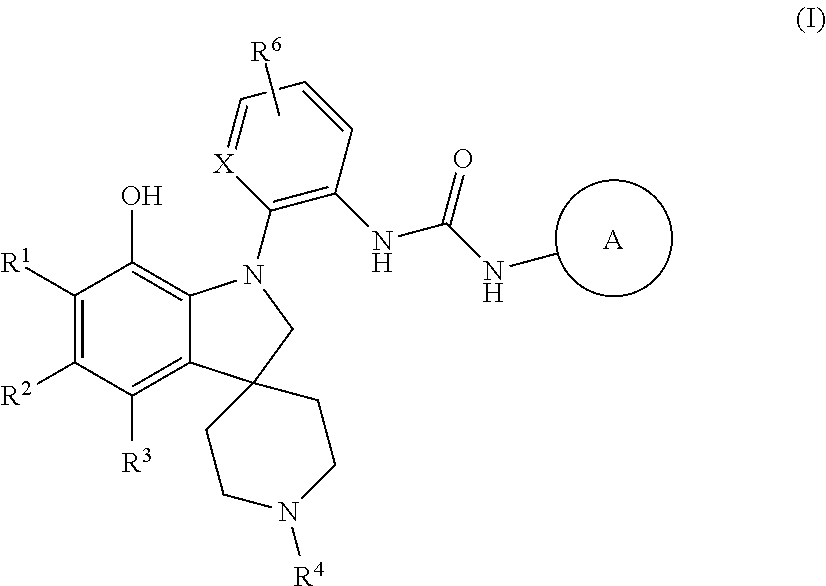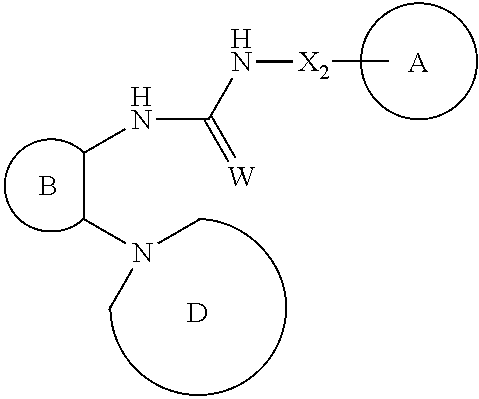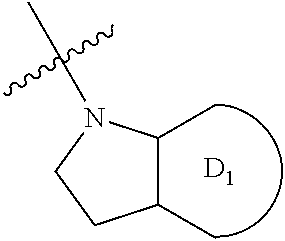7-hydroxy-spiropipiperidine indolinyl antagonists of p2y1 receptor
a technology of p2y1 receptor and indolinyl antagonist, which is applied in the field of 7hydroxyspiropiperidine indolinyl compounds, can solve the problems of in vivo study of the antagonist without the necessary pharmacological properties
- Summary
- Abstract
- Description
- Claims
- Application Information
AI Technical Summary
Benefits of technology
Problems solved by technology
Method used
Image
Examples
example 1a
[0444]1-(2-(7-Methoxy-1′-pivaloylspiro[indoline-3,4′-piperidine]-1-yl)phenyl)-3-(4-(trifluoromethoxy)phenyl)urea: In a 100-ml round bottomed flask, to Intermediate 2 (1.55 g, 3.93 mmol) in THF (19 mL) was added 1-isocyanato-4-(trifluoromethoxy)benzene (594 μL, 3.93 mmol). The mixture was stirred for 2 h at 23° C., and then was concentrated in vacuo. The crude material was purified by flash chromatography (BIOTAGE®) eluting with 30-50% ethyl acetate: 70-50% hexanes to afford 2.17 g (yield: 92%) of Example 1A. 1H NMR (400 MHz, DMSO-d6) δ ppm 9.54 (s, 1H), 8.42 (s, 1H), 8.08-8.14 (m, J=7.58 Hz, 1H), 7.52-7.57 (m, 2H), 7.28 (d, J=8.34 Hz, 2H), 7.07 (ddd, J=8.34, 6.19, 2.65 Hz, 1H), 6.85-6.90 (m, 4H), 6.81-6.84 (m, 1H), 4.26 (d, J=13.64 Hz, 1H), 4.16 (d, J=12.13 Hz, 1H), 4.08 (d, J=10.61 Hz, 1H), 3.48 (s, 3H), 3.27 (d, J=10.61 Hz, 1H), 2.81-2.92 (m, 2H), 1.80-1.87 (m, 1H), 1.68-1.79 (m, 2H), 1.58-1.65 (m, 1H), 1.18 (s, 9H). LCMS (ESI) m / z 597 (M+H)+, RT=2.143 min (Method B).
example 1b
[0445]1-(2-(7-Hydroxy-1′-pivaloylspiro[indoline-3,4′-piperidine]-1-yl)phenyl)-3-(4-(trifluoromethoxy)phenyl)urea: To Example 1A (2.1 g, 3.52 mmol) in DCM (35 mL) at −20° C., was added 1M BBr3 solution in DCM (8.8 mL, 8.8 mmol) dropwisely. The mixture was allowed to reach 0° C. and stirred for 3 h. At 0° C., BBr3 solution in DCM (8.8 mL, 8.8 mmol) was added, and then the reaction temperature was allowed to reach 23° C. The mixture was stirred for 2 h, and then neutralized with NH4OH. The resulting mixture was stirred for 15 min and layers were separated. The organic layer was poured into 1N HCl, and extracted with DCM (2×). The combined organic layers were washed with water, dried over Na2SO4, filtered and concentrated in vacuo. The crude material was purified to give 1.294 g (yield: 63%) of Example 1B. 1H NMR (400 MHz, DMSO-d6) δ ppm 9.58 (s, 1H), 8.98 (s, 1H), 8.43 (s, 1H), 8.11 (d, J=8.08 Hz, 1H), 7.52-7.58 (m, 2H), 7.28 (d, J=8.34 Hz, 2H), 7.05 (ddd, J=8.27, 4.42, 4.23 Hz, 1H), 6...
example 1
[0446]1-(2-(7-Hydroxy-1′-neopentylspiro[indoline-3,4′-piperidine]-1-yl)phenyl)-3-(4-(trifluoromethoxy)phenyl)urea: In a 100-ml flask, to Example 1B (1.29 g, 2.21 mmol) in THF (11 mL) was added LiAlH4 (151 mg, 3.99 mmol) at 23° C. The mixture was stirred at 23° C. for 6 h, and 100 mg of LiAlH4 was added. The mixture was stirred for additional 16 h at 23° C. It was poured into Rochelle's salt solution, stirred for 16 h and filtered over CELITE®. It was extracted with ethyl acetate (3×), washed with Rochelle's salt solution, water, brine, dried over Na2SO4, filtered and concentrated in vacuo. The crude material was purified by flash chromatography (BIOTAGE®) eluting with 20-35% ethyl acetate: 80-65% hexanes to afford 1.05 g (83%) of Example 1 as an off-white solid. 1H NMR (400 MHz, DMSO-d6) δ ppm 9.56 (s, 1H), 8.96 (s, 1H), 8.37 (s, 1H), 8.05 (d, J=8.34 Hz, 1H), 7.55 (d, J=9.09 Hz, 2H), 7.28 (d, J=8.84 Hz, 2H), 7.03 (td, J=7.52, 1.64 Hz, 1H), 6.80-6.88 (m, 2H), 6.71-6.79 (m, 2H), 6.60 ...
PUM
| Property | Measurement | Unit |
|---|---|---|
| temperatures | aaaaa | aaaaa |
| temperatures | aaaaa | aaaaa |
| temperatures | aaaaa | aaaaa |
Abstract
Description
Claims
Application Information
 Login to View More
Login to View More - R&D
- Intellectual Property
- Life Sciences
- Materials
- Tech Scout
- Unparalleled Data Quality
- Higher Quality Content
- 60% Fewer Hallucinations
Browse by: Latest US Patents, China's latest patents, Technical Efficacy Thesaurus, Application Domain, Technology Topic, Popular Technical Reports.
© 2025 PatSnap. All rights reserved.Legal|Privacy policy|Modern Slavery Act Transparency Statement|Sitemap|About US| Contact US: help@patsnap.com



